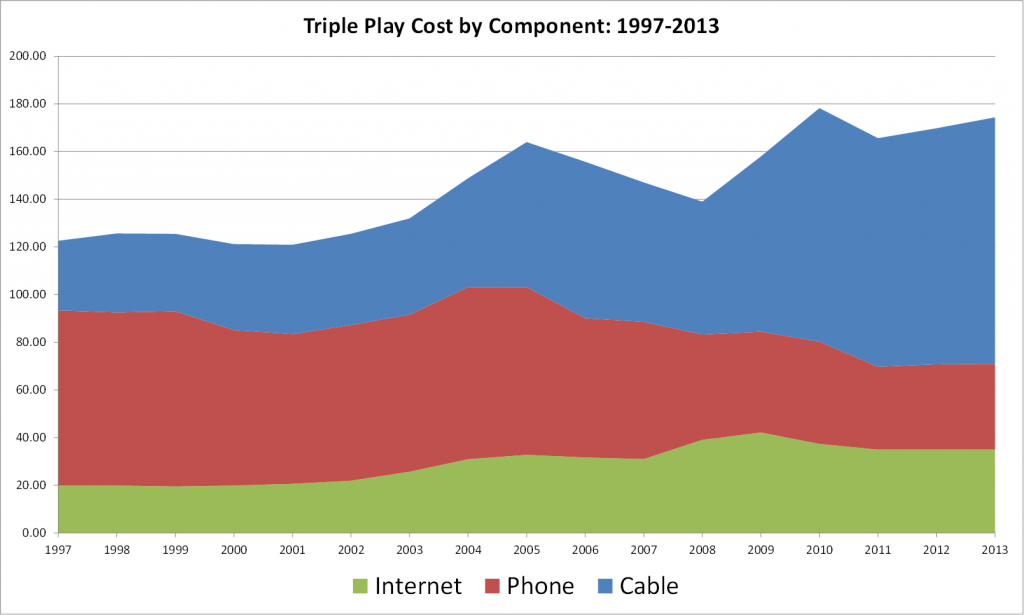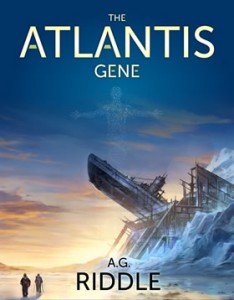 The Amazon recommendation engine contains a bottomless pit of suggestions, especially after you fill it up with enough purchases. Since I’ve been on a reading binge this year, the book recommendations have been coming faster than ever, and they’ve gotten better (which is why I “hate” the engine). One of the latest recommendations I received was for The Atlantis Gene by A.G. Riddle. It was the trifecta of Amazon recommendations – the description looked interesting, it had received an overwhelming number of positive reviews, and I could borrow it through the Kindle lending library. Obviously, I loaded it up.
The Amazon recommendation engine contains a bottomless pit of suggestions, especially after you fill it up with enough purchases. Since I’ve been on a reading binge this year, the book recommendations have been coming faster than ever, and they’ve gotten better (which is why I “hate” the engine). One of the latest recommendations I received was for The Atlantis Gene by A.G. Riddle. It was the trifecta of Amazon recommendations – the description looked interesting, it had received an overwhelming number of positive reviews, and I could borrow it through the Kindle lending library. Obviously, I loaded it up.
Monthly Archives: November 2013
My favorite time of the year
Now that we’ve made it through Black Friday, I’m ready to jump into my favorite time of the year. I am NOT a fan of Black Friday and all the hype leading up to it, but I absolutely love the four weeks between Thanksgiving and Christmas. I know that it stresses some people out, but I see it a fun and enjoyable time.
For starters, I thoroughly enjoy listening to Christmas music. As soon as I finish Thanksgiving dinner, I’m ready to start playing my Christmas playlists, CDs, , Pandora, and Sirius-XM holiday stations. I wish I could list all of my favorite tunes here, but there are just too many. I don’t know what it is, but Christmas songs are timeless classics for me.
Second, I really enjoy building up the anticipation of Christmas with the family. This time of year can be such a fun time for the kids, and I try to make sure they see it this way. I want them to enjoy so they will be able to impart the same feelings sense of excitement to their families when they get older.
Perhaps, most of all, I enjoy the get togethers and parties that mark this time of the year. It’s so much fun to get together, spend time with friends and family, and enjoy good food and drink. Even though I see my friends throughout the year, spending time with them over the holidays is even more special to me.
Finally, this time of year is a good time to reflect on the past year and get ready to start fresh in a new year. I like to live by the motto of learning from the past, living for today, and dreaming about tomorrow. In other words, I don’t dwell on the past, but I like to take what I can from the past year and apply to the next year to improve upon whatever areas need work. I’m not sure yet what I’m going to choose to focus on next year, but I’m pretty pleased about how this past year turned out. Hopefully, I’ll feel the same way next year at this time!
Book Review: Zero Day
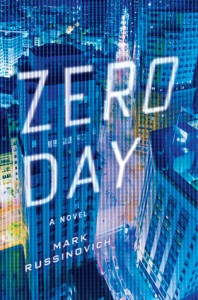 After being a bit disappointed with Cyberstorm by Matthew Mather, I decided to read Zero Day by Mark Russinovich. Zero Day is similar to Cyberstorm in that both books are stories about computer viruses gone wild that wreak havoc and destruction on the computer infrastructure of the United States.
After being a bit disappointed with Cyberstorm by Matthew Mather, I decided to read Zero Day by Mark Russinovich. Zero Day is similar to Cyberstorm in that both books are stories about computer viruses gone wild that wreak havoc and destruction on the computer infrastructure of the United States.
Zero Day starts out by describing a series of apparently unrelated computer glitches. One of these glitches threatens to bring down a major New York City law firm, so their IT department calls upon Jeff Aiken to identify and fix the problem. Aiken has a history in IT security, as well as a history working within the IT groups of various government intelligence agencies. Aiken ends up calling in a couple of favors from one of his former government colleagues, Daryl Haugen, an attractive government IT security specialist who is investigating the source of these unrelated computer glitches.
Through their work together, they discover that the glitches are related. What ensues is an action packed trek across the globe to identify the source of the virus and stop those behind it before they unleash destruction on the infrastructure of both the United States and the world at large. It’s a page turner that is full of action and suspense that I found hard to put down.
Unfortunately, the chase to stop the virus only takes up the last third of the book. The first two-thirds of the novel is slow developing and was difficult for me to power through. Sure, some of it helped to build up to the ending, but there were a couple of gratuitous violence and sex scenes that felt unnecessary and loosely connected to the story. It was like scenes you see in a movie that are purely inserted for visual entertainment but serve no real purpose in moving the story forward.
That being said, I found Zero Day to be much better than CyberStorm. While Zero Day moved a little slower at the beginning, the story felt more believable than the surreal catastrophic picture that Cyberstorm painted. It also got into more of the details and explained the science behind computer viruses, which I enjoyed.
I wouldn’t put Zero Day in my must read category, nor would I recommend putting it at the top of your reading list. However, if you’re interested in being entertained while learning about the risks and effects that a large scale computer virus attack could have our infrastructure, then Zero Day is one of the best books out there. Let’s just say that it was good enough that I’ve put the second book in the series, Trojan Horse, on my reading list for next year.
Analyzing the cost of the triple play
As a fun exercise using the magic of Quicken, I created a graph of my triple play cost (phone+cable+internet) since 1997. Even though the data was collected in monthly intervals, I averaged the cost annually to smooth out fluctuations, which were especially prevalent in the phone data pre-2008 when long distance phone calls were still being charged by the minute.
Analyzing the triple play cost
What the data shows us is not a surprise, and I suspect that is indicative of what is happening in most households. The overall cost of the triple play has increased ~50% over the last 15 years from $120/month to $175/month. However, it’s not the total cost of the triple play that’s noteworthy. It’s trends in the individual components that are interesting. Namely,
- The value of landline phone service is declining
The cost of phone service has been cut in half over the last 15 years and will continue to drop, eventually reaching zero. I’m not surprised given that I rarely use my landline. I’m paying $30/month to rent a phone number to give to telemarketers. When I look at my children, who have grown up with a cellphone as their primary means of communication, I doubt any of them will ever pay for landline service in their lifetime, which portends the end of landline service as we know it in the not too distant future. - Advances in internet service have far outpaced the cost
Once could argue that paying $20/month for unreliable 56kbps internet service that was metered by the hour was ridiculously overpriced, but it is the baseline. Compare that to paying $35/month for a pipe that is reliable, is always on and delivers 15Gbps, and it’s clear that internet service is a bargain these days, a HUGE one! Stated more bluntly, the service is infinitely more reliable and over 250,000 times faster. If speed and cost were directly proportional, I should be paying over $5,000,000/month for internet service today. As it stands, internet costs haven’t even doubled over the last 15 years. - Cable’s cost increase doesn’t match it’s value proposition
While the number of channels I receive has increased from 70 to over 600, the number of channels I watch has changed from 10 to about 15. I’m paying over 3x the amount for a service whose value proposition hasn’t changed significantly. If you were to cut off my cable service tomorrow, I might miss watching sports and a few Seinfeld reruns, but other than that, I’m not sure I’d notice. On other hand, if you were to turn off my internet service, I’d be reaching for my checkbook.
What the analysis tells us
- Cord-cutting is not a fad
Disputes over content distribution, like the one that happened between Time-Warner and CBS are becoming more and more common and are continuing to drive up the cost of the cable. People are tired of being held hostage to the cable companies and content providers and aren’t going to tolerate it. The result will be more cord-cutting. You can get by without cable today by using an over the air antenna and internet services like Netflix and Amazon Instant Video, but it’s not quite the same. However, these solutions are improving rapidly, and it’s only a matter of time before cord-cutting catches up to and surpasses the content provided by cable. - The cable business is ripe for disruption
Bundling of content is not a sustainable business model. I don’t want to pay for a service where I don’t use 90% of what is being supplied. If the cable companies do not recognize that their value is in the delivery network and not the bundling of content, they will be marginalized by more innovative and progressive thinking companies like Netflix, Amazon, HBO and YouTube (Google). Cable needs to move to a different model, such as a la carte or on-demand programming, sooner rather than later.
Where we’re headed
I’ve believed for over 10 years that content programming would migrate to an on-demand model. I thought for sure that it would’ve happened by now, but the entrenched players have been slow to move and have used government lobbying to slow down and impede competitive services. History has shown that these tactics only delay the inevitable. The companies that refuse to change are eventually replaced by those that embrace the new business models.
Bottom line, the cable companies and content providers need to start allowing us to choose what we want, when we want it, and only charge us for what we use. Otherwise, we’re going to start letting companies into our living rooms that will.
Book review: Technopoly
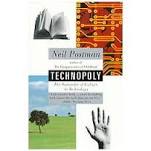 I was so impressed with Amusing Ourselves to Death by Neil Postman, that I decided to read his follow-up, Technopoly: The Surrender of Culture to Technology. Overall, it’s a well written piece that reinforces the concepts from Amusing Ourselves to Death, which was my biggest disappointment with the book. It just didn’t feel like Technopoly covered a lot of new ground.
I was so impressed with Amusing Ourselves to Death by Neil Postman, that I decided to read his follow-up, Technopoly: The Surrender of Culture to Technology. Overall, it’s a well written piece that reinforces the concepts from Amusing Ourselves to Death, which was my biggest disappointment with the book. It just didn’t feel like Technopoly covered a lot of new ground.
Now don’t get me wrong, I’m not saying or suggesting that the concepts covered in the book aren’t thought provoking or relevant in today’s tech-centric society. In fact, the concepts in the book are more relevant today, and will be even more relevant in the future, than when Postman originally wrote the book in 1992. It’s just that I had set the bar so high after reading Amusing Ourselves to Death that I was let down a bit.
If I had read Technopoly prior to reading Amusing Ourselves to Death, then I’m sure I’d be writing a different review. I’d be rambling on about how Postman predicted the dark side of technology and its adverse effects on society and how we need to be heed his concerns to avoid becoming tools of technology rather than using technology as tools.
In summary, I’m a huge fan of Postman’s work, and Technopoly does not change my opinion of Postman or his teachings. If anything, it reinforces it with more examples of how technology is continually fraying the fabric of our society, most time in ways that we are unaware of or oblivious to. I’d recommend reading Technopoly, especially if you haven’t read, or don’t intend to read Amusing Ourselves to Death. On the other hand, if you’ve already read Amusing Ourselves to Death, set your expectations appropriately and don’t expect to be blown away by Technopoly. It will merely build upon and reinforce the concepts Postman introduces in his earlier work.
Places to go – San Francisco
Since I’ve lived in California, I’ve never been a big fan of Northern California, especially the Silicon Valley-San Jose-Sunnyvale area. I’m not sure what bothers me, but I never enjoyed traveling there. San Francisco, however, is an exception. It is one of my favorite cities in the world to visit.
I was in San Francisco last week for a conference and had some time to explore the city. Here’s a few of my favorite places to go while I’m there, and a couple of new places I discovered:
1. Scala’s Bistro
One of my favorite places to eat in the city. It’s just off Union Square on Powell Street. I’ve had a couple of great meals there, although I wasn’t able to eat there last time around. I failed to make a reservation and didn’t feel like waiting 3 hours. Needless to say, it gets crowded, especially on the weekends.
2. Ghiardelli Square
Yes, this is a bit touristy, but I always enjoy stopping by Ghiardelli Square while I’m in the city. There’s nothing like swinging by the Ghiardelli chocolate shop for a few treats. My favorites are the dark chocolate sea salt and caramel squares and the chocolate covered strawberries.
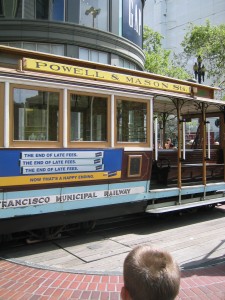 3. Union Square
3. Union Square
Union Square is the center of the city in my mind. It’s hard for me to recall a visit to San Francisco where I didn’t end up spending quite a bit of time around Union Square area, and my most recent trip was no exception.
4. The Cable Cars
Like Ghiardelli Square, it’s a bit touristy, but it never gets old for me, particularly on the Powell & Mason Street Line. The views are absolutely incredible on a clear day, especially when you crest the hill on Powell Street and get a clear view of Alcatraz Island. Plus, it sure beats the walk from Union to Ghiardelli Square.
5. Blue Bottle Coffee
 I’m not the biggest coffee drinker, but Blue Bottle Coffee was highly recommended on my latest trip to the city. It’s a bit tough to find in Mint Plaza, which is a bit off the beaten path, but you’ll know you’ve found it when you see the line. I waited 20 minutes for a Cafe Mocha, and it was worth every minute of it. My only regret was eating breakfast before I went. I should’ve waited and had a bowl of the steel cut oats that was on their menu.
I’m not the biggest coffee drinker, but Blue Bottle Coffee was highly recommended on my latest trip to the city. It’s a bit tough to find in Mint Plaza, which is a bit off the beaten path, but you’ll know you’ve found it when you see the line. I waited 20 minutes for a Cafe Mocha, and it was worth every minute of it. My only regret was eating breakfast before I went. I should’ve waited and had a bowl of the steel cut oats that was on their menu.
6. Tank 18
On Sunday evening, I was looking for a place where I could relax and have a glass of wine. Tank 18 showed up on a Google search, so I decided to check it out. I was pleasantly surprised. They bottle their own wine and had a very tasty Syrah. I was drawn there by a Meritage I saw on their website, but the waitress told me that it was extremely popular (and very good) and had sold out. I’m sure I’ll find my way back here on a subsequent trip.
7. Rue Lepic
When my daughter and her boyfriend, whom I met up with while on my last trip, couldn’t get into Scala’s Bistro on Saturday evening, we headed up the hill to Rue Lepic, a small French restaurant at he corner of Pine & Mason. It’s an intimate setting with only about 8-10 white-cloth tables. We had a great dinner, and I would recommend it. I’ve added it to my list of restaurants to head back to while in the city.
I’m looking forward to my next trip to San Francisco and adding a few more items to my list of places to check out.
Book review: Terms of Enlistment
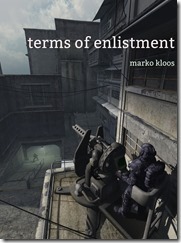 In searching for my next entertainment novel, I stumbled across Terms of Enlistment by Marko Kloos. Given that I could read it for free via the Kindle Owners’ Lending Library, I figured that I’d give it a try. I’m glad I did.
In searching for my next entertainment novel, I stumbled across Terms of Enlistment by Marko Kloos. Given that I could read it for free via the Kindle Owners’ Lending Library, I figured that I’d give it a try. I’m glad I did.
Terms of Enlistment paints a dystopian view of the future. America’s major cities have deteriorated into welfare slums where people have no way out unless they are selected by lottery to colonize other planets, or they join the military. In the case of Andrew Grayson, he decides to join the military to escape the slums of Boston.

